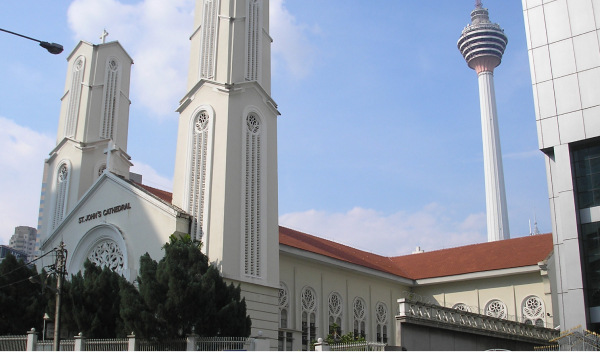
In a land area of 63,810 square kilometers, the diocesan territory covers four states (Selangor, Negeri Sembilan, Pahang, Trengganu) and two federal territories (Kuala Lumpur and Putrajaya).
The population is 10,489,267 as of 2009, majority of whom are ethnic Malays. There are sizable numbers of ethnic Chinese and Indians. Other minorities include Eurasians and Orang Asli (aborigines).
Malay or Bahasa Malaysia is the official language. English, Mandarin and other Chinese dialects and Tamil are also in use.
In 1511, Malacca was conquered by the Portuguese, who in 1641 lost the territory to the Dutch who in 1795 were forced to leave when the British became the colonial ruler. In 1545 Francis Xavier was engaged in missionary work in Malacca, and after his death on the island of Shangchuan on Dec. 3, 1552, his body was kept for some time in Malacca before it found its final resting place in Goa.
In 1554, Dominican friars came into the country, and in 1557 the diocese of Malacca was erected as suffragan diocese of Goa.
The beginnings of the missionary activities in West Malaysia are directly connected with the persecution of the Catholic Church in Siam by King Phaja Tak who in 1779 targetted apostolic vicar Msgr. Le Bon and other Catholic priests.
In 1810, the regional major seminary was opened on the peninsula of Penang.
In 1838, the Malaysian peninsula together with Singapore was put under the jurisdiction of the apostolic vicariate Ava and Pegu in Burma.
From 1840 onwards, the jurisdiction was shifted to the apostolic vicariate of Siam. In 1886, the Catholics living in Malacca and Singapore were put under the jurisdiction of the bishop of Macau.
In 1888, Pope Leo XIII erected the diocese of Malacca with the episcopal see in Singapore as suffragan diocese of Pondicherry, India.
Beginning in 1852, the Teaching Brothers of de la Salle (FSC) and the Sisters of St. Maur started their first schools in Malaysia to counter the influence of the Methodists. The Catholic schools became the most important instrument of the apostolate and generally helped bolster the image and the influence of the Catholic Church among the population.
In 1953, the canonical character of the diocese of Malacca was changed to become an archdiocese and two years later, in 1955, the Catholic hierarchy was erected in the country.
The new ecclesiastical province comprised the archdiocese of Malacca-Singapore with the suffragan dioceses of Kuala Lumpur and Penang. When Singapore left the Federation of Malaysia in 1965, a re-organization of the ecclesiastical structures became necessary.
In 1972, Kuala Lumpur was made an archdiocese with the newly founded suffragan diocese of Melaka-Johor. Furthermore, the archdiocese of Singapore was directly subordinated to Rome.
In 1980, the total number of Catholics in the Federation of Malaysia was 440,000 while the total population of Malaysia was 13,4 million.
The country's main international airport is located at Sepang, about 70 kilometers south of Kuala Lumpur. Other commercial airports are in Kuala Trengganu, Kuantan and Subang. The country's main seaport is Port Klang, about 50 kilometers west of Kuala Lumpur. Other seaports are Kuantan and Port Dickson. The territory has a very good road system. The country's main railway line runs through Kuala Lumpur, connecting it with Singapore in the south and Thailand in the north. Several other railway lines, including a monorail, run around Kuala Lumpur and surrounding urban areas.
Equatorial (hot and wet throughout the year)
Kuala Lumpur is the economic and business center of the country. The city and its surrounding urban areas form the most industrialized and fastest-growing economic region in Malaysia. Most of the countries' largest companies have their headquarters based here. Manufacturing and heavy industries are concentrated in the west coast. Agriculture includes mainly oil palm and rubber plantations in the west-coast states of Selangor and Negeri Sembilan. Petroleum and gas are the main contributors of the economy of the eastern state of Trengganu. Timber is an important industry in the interior of Pahang state, while fisheries is important in the state's east coast. Tourism plays an important role in the economy. Tourism centers are Kuala Lumpur, Taman Negara (a national park in the north of Pahang), Cameron Highlands and Genting Highlands (both mountain resorts in the interior of Pahang) and the beaches and islands off the coasts of Pahang and Trengganu.
Several mountain ranges run along the territory, which also comprises hilly areas, valleys and plains.